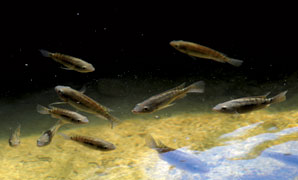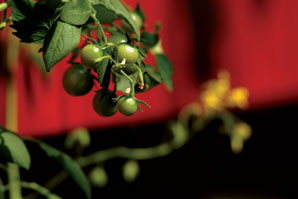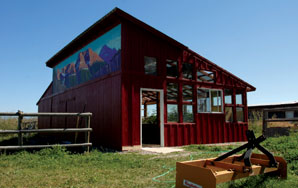When the work dried up, Bryan Hays and R.D. Aegerter turned away from construction and sought a new line of work. Today, they have staked their future on an unlikely foray into “aquaponics” food production, an endeavor that requires both patience and lots of fish feces.
If done correctly, Hays and Aegerter, along with landscape painter Mark Ogle and his son Dave, believe aquaponics is both a commercially viable and sustainable form of organic food production.
Using their construction expertise, Hays and Aegerter teamed up with the Ogles to remodel a barn into a self-contained aquaponics system on the Ogles’ property in Kalispell. Mark Ogle, the noted painter, lent his artistic skills and painted a mural on the side of the barn.
“Where this is catching on it’s going crazy; it’s going viral,” Ogle said. “Ours is a prototype system, but we want to talk to local businesses and see it happen on a commercial scale in the valley.”
 |
|
Tilapia swim in a tank at an aquaponics facility off Valley View Drive west of downtown Kalispell. The nutrient rich water is pumped from the tank into trays above where it is filtered and used to grow fruits and vegetables before being funneled back into the tank. |
Aquaponics systems are mini ecosystems that grow both fish and vegetables, using the fish waste as fertilizer for the plants. Ogle and Hays say the systems have gained popularity in the U.S and across the globe. Earlier this month, Chicago State University completed a large aquaponics facility.
But, as far as Ogle and Hays know, aquaponics is virtually unheard of in Montana. With the uncertainty of global markets and food prices, Ogle thinks it’s time more people – in Montana and everywhere – begin taking a hard look at where their food comes from.
Aquaponics, utilizing basic tenets of hydroponic growing, is yet another manifestation of the local foods movement. Small-scale organic farmers and community-supported agriculture (CSA) operations can be found throughout the Flathead Valley. And a Kalispell-based hydroponics company has emerged as a significant local provider of tomatoes.
But where aquaponics diverges from other hydroponic growing techniques is in its farming of fish, in addition to veggies. At the facility on the Ogles’ property, tilapia are raised for consumption and for their waste. The waste is diverted through a separation system and used as fertilizer for the vegetables.
This way, the tilapia’s water stays clean and the plants get nutrients. Furthermore, potentially harmful gases from the waste aren’t released into the atmosphere.
“The plants get fed and it filters the water for the fish – it’s a complete ecosystem,” Hays said.
 |
|
Vine tomatoes grow at an aquaponics facility off Valley View Drive west of downtown Kalispell. |
Hays and Aegerter led the construction efforts that turned a dilapidated barn into a sharp-looking growing facility six months ago. Several months later, they planted their first vegetables and have since had one productive harvest, which rendered healthy amounts of chard, tomatoes, green beans, cucumbers, squash and more.
“They’re fabulous,” Ogle said of the vegetables. “There’s nothing you’re eating in here that’s not pure.”
Hays traveled to San Diego to meet with Colle Davis, who operates an aquaponics company called Portable Farms. Hays gathered information to help build the Kalispell system.
The size of the Ogles’ barn fits loosely into the framework of Portable Farms’ 20-by-30-foot model system. Portable Farms claims the 20-by-30-foot model, using two fish tanks, can produce sufficient vegetables for five adults to consume daily and enough fish to eat several times a week, year round on a continual basis.
Hays said he and his colleagues are learning as they go, and he admits that “we’re not farmers, we’re builders.” After the initial harvest, they ran into problems. Apparently, they hadn’t maintained the proper temperature for the fish and killed a number of them. Without the fish’s waste, the vegetables suffered. Not to mention, the fish never got big enough for eating.
“We should have 200 fish and we only have 50,” Hays said. “But we figured out the problem and we’re ready to get on a roll.”
With each day serving as a lesson, the men are running into pleasant surprises as well. For example, Aegerter discovered that some seeds, randomly tossed into the gravel, have started to sprout.
The system uses trays full of gravel and, usually, the seeds are planted in an organic non-soil substance placed throughout the gravel. Because no soil is used, Hays said he is learning what types of plants do best. Further experimenting will occur in the winter when the men will have to maintain appropriate temperatures within the facility, which is essentially a greenhouse.
 |
|
Decorated with a mural by local artist Mark Ogle, a dilapidated barn was transformed onto an aquaponics facility on the Ogle’s property off Valley View Drive west of downtown Kalispell. |
Using the current prototype as a launching point, Hays hopes to begin building the systems at a commercial level. He also has a small portable model that he had on display at the Northwest Montana Fair. He plans to bring it to local schools.
“I’m pretty excited about where it could go,” Hays said of aquaponics’ commercial viability in the Flathead. “It’s been proven now that it works and it’s profitable.”
He added: “I’d like to see contractors building these all over the valley. Put the builders back to work.”
As for Ogle, he said he has “zero interest in making money; my interest is feeding people.” He would love to see them pop up across the valley.
“If we get the word out I think we’ll have a fighting chance of making this happen,” Ogle said. “Otherwise, if not, we’ll still have it for our own house use.”